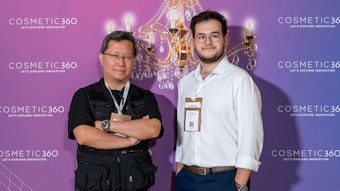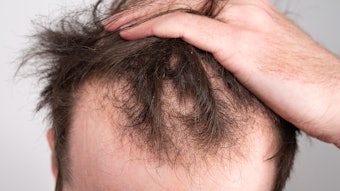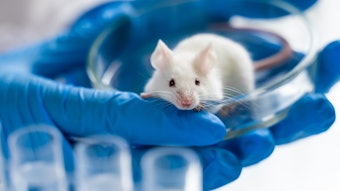
Editor's note: Diminished folate levels impact the rate of DNA damage, thus this article from our archives explores how reinforcing skin folates prior to UV exposure could protect against DNA damage. The predominant natural folate in skin, 5-MTHF, is intrinsically stable under UV, but can degrade if photosensitizers are present. Sub-micromolar 5-MTHF protects DNA against oxidation, and ascorbate levels in skin help maintain this folate.
This article is only available to registered users.
Log In to View the Full Article
Editor's note: Diminished folate levels impact the rate of DNA damage, thus this article from our archives explores how reinforcing skin folates prior to UV exposure could protect against DNA damage. The predominant natural folate in skin, 5-MTHF, is intrinsically stable under UV, but can degrade if photosensitizers are present. Sub-micromolar 5-MTHF protects DNA against oxidation, and ascorbate levels in skin help maintain this folate.
The risk for developing skin cancer is strongly related to sun exposure.1 Both UVB and the more deeply penetrating UVA components of solar radiation stimulate the progression of melanoma.2 Moreover, the lamps used in modern tanning beds, though predominately UVA, are often more intense than in natural sunlight. Indeed, squamous and basal cell carcinoma and melanoma have been associated with tanning bed use.3-7
Several mechanisms inherent to the skin help mitigate the damage caused by UV radiation. The first is the physical block provided by pigmentation. It is well-known that darker-skinned individuals have a much lower risk of skin cancer than lighter-skinned individuals. However, the penetration of UVB into the basal layers of the epidermis is required for the photo-conversion of 7-dehydrocholesterol to pre-vitamin D3.
It has been hypothesized that the need for adequate vitamin D production drove the evolution of lighter skin color in early human populations that migrated from Africa into northern latitudes, where annual UV exposure is less intense.20 On the other hand, those having little melanin who have moved closer to the equator, such as in northern Australia, experienced especially higher rates of skin cancer.
In addition to pigmentation, DNA repair mechanisms are another class of inherent protection aimed at preventing permanent radiation damage. DNA lesions can be induced by UVA in cell cultures and human skin via a number of processes. One such process and a major contributor is the formation of bypyrimidine photoproducts such as cyclobutane pyrimidine dimers (CPD).8-10 For the UVA band, CPD are believed to arise both from direct absorption by DNA and photosensitization reactions.9, 11, 12
The next most prevalent contributor to DNA damage is the formation of 8-oxo-deoxyguanosine (8-oxo-dGua), although the ratio of this to CPD has been reported to be dependent on the cell type. This oxidized base can arise from the action of singlet oxygen,13, 14 hydroxyl radicals or type-I photosensitized one-electron transfer.9 Strand breaks can be produced by additional oxidation of DNA containing 8-oxo-dGua.9, 15 Although it is still debated,9 several laboratories have provided evidence for the formation of both replication-dependent and replication-independent double-strand breaks by UVA mediated by reactive oxygen species (ROS).16
Of the various forms of DNA damage, double strand breaks may be the most problematic.17 These can be repaired by homologous recombination by cells during the S or G2 phases of mitosis, or by non-homologous end joining (NHEJ), mostly during the G1 phase. However, since NHEJ does not match against a homologous segment and does not always have the exact single strand overhang required to restore the original sequence, this method is especially prone to errors found in cancers.18
These and other activities such as base excision repair, which can replace 8-oxo-dGua, and nucleotide excision repair, which can replace CPD, are a second line of defense against the harmful effects of radiation on DNA. However, DNA repair essentially equates to trying to close the barn door after the horse has escaped.
Yet another inherent mechanism is the interception of reactive species generated by UV, and work in our lab has identified a specific entity capable of doing so even prior to their interacting with DNA: folate.24
In considering the role of human pigmentation, it was previously suggested that darker skin could not only protect DNA, but also slow the photodegradation of the folate pool.19, 20 Stemming the loss of folate in regions having intense UV radiation also helped to prevent birth defects and/or decrease the risk for cancer.20, 21 However, much of the initial concern about the impact of light on folate was based on the well-known photolability of folic acid. This synthetic form is not a participant in physiological, folate-dependent, one-carbon metabolism (see Figure 1) unless converted by the slow action of dihydrofolate reductase.22
Thus, since little was known about the photochemistry of natural folates, we investigated them primarily using 5-methyltetrahydrofolate (5-MTHF). This folate is the most abundant form in blood and many tissues, especially the skin.23 The present work not only demonstrated the circumstances under which this folate is or is not degraded by light, but also revealed a new mechanism for the protection of biomolecules, especially in the aqueous intracellular compartment.
Several mechanisms of protection against the effects of UV are afforded by maintaining skin folate at optimum levels.
Folate Stability to UV and Photosensitization
The stability of 5-MTHF under both UVA and UVB was tested. However, even in the absence of light, 5-MTHF in aqueous solutions is susceptible to metal catalyzed reactions with molecular oxygen. Correctly assessing its photostability therefore requires working with metal-free buffer, in which only approximately 1% is lost over the course of 80 min at near-ambient temperature in the dark. Irradiation with 2.3 mW/cm2 of UVA or 2.2 mW of UVB (filtered to remove UVC) induced a first order loss of 5-MTHF at 0.0004 min-1 and 0.0008 min-1, respectively (see Figure 2). The slightly higher rate caused by UVB may be related to its extinction maximum at 290 nm when at a neutral pH.
While direct photo-degradation is negligible in a physiological context, 5-MTHF was discovered to be decomposed in the presence of photosensitizers such as pterin-6-carboxylic acid with UVA, or rose bengal with visible light.24 This has subsequently been investigated in vitro using several naturally occurring photosensitizers: riboflavin, uroporphyrin and conjugated bilirubin.25 Other endogenous photosensitizers in skin include trans-urocanic acid, tryptophan oxidation products, pyridinoline collagen cross-links and melanin precursors.26
The potential loss of folate within skin could have multiple effects. Folate dependent one-carbon metabolism participates in the biosynthesis of the purine bases and also thymidylate; and a depleted folate pool (see Figure 1) could hinder DNA repair, as has been demonstrated in cell culture, and lead to non-reversible damage.27 Regulation of DNA transcription also is, in part, mediated by methylation reactions that are dependent on S adenosylmethionine, the supply of which can in turn be influenced by the level of 5-MTHF. Both hyper- and hypomethylation of DNA have been reported in skin cancer as well as other cancers.28, 29
Folate Effect on UV-induced DNA Damage
While investigating whether 5-MTHF might exacerbate UV-mediated DNA damage, another previously unknown aspect of the photochemistry of this natural folate was revealed. It had been reported that folic acid can catalyze UVA oxidation of DNA particularly targeting G-G repeats to form 8-oxo-dGua.30 The main culprit is pterin-6-carboxylc acid (PCA), arising from the photolysis of the folic acid C9-N10 bond yielding p-aminobenzoic acid and initially, pterin-6-carboxaldehyde; the latter being subsequently oxidized to PCA.
Both pterin scission products are much more efficient photosensitizers than folic acid itself.31 This can be seen in the accelerating self-destruction of folic acid during photolysis with UVA, which was about three-fold less intense than the UVA used to examine the loss of 5-MTHF (see Figure 2). Thus, the idea that nature might have selected a form of folate more resistant to photosensitization reactions than synthetic folic acid was explored.
The fragmentation of plasmid supercoiled DNA (PBR 322) was used to examine the photosensitization of folates by UV.24 When this is nicked by a single strand break, it is converted into a relaxed circular form: a double strand break opens the DNA altogether to generate a linear form. The supercoiled, relaxed and linear forms can all be separated by gel electrophoresis. As expected from the work of Hirakawa et al.,30 exposure of supercoiled DNA to 4 J/cm2 of UVA in the presence of folic acid converted a large percentage to the linear form.
However, a similar experiment carried out with the same concentration of 5-MTHF produced no more relaxed or circular DNA than was present as a contaminant of the original plasmid preparation (see Figure 3a). Thus, this natural folate does not initiate photosensitized cleavage of DNA even in concentrations exceeding those found in skin.
The big surprise was the result of an experiment that included both folic acid and 5-MTHF, where no DNA cleavage was observed. Moreover, so long as the concentration of 5-MTHF was maintained (by constant infusion with a syringe pump) at 500 nM—a level equivalent to that found in the epidermis23—no degradation of the folic acid was detected. In other words, both the photo cleavage of the folic acid and that of DNA were blocked.
This effect was observed with other sensitizers as well. For example, the more potent PCA, with both UVA (see Figure 3b) and UVB filtered to remove any UVC content (data not shown).
Of the various forms of DNA damage, double strand breaks may be the most problematic.
Mechanism of 5-MTHF with Photosensitizers
The mechanism(s) by which 5-MTHF exerts its influence on photosensitization were then explored. Competition reactions were performed with 5-MTHF and varied azide, a potent (4.5 × 108 M-1s-1 in water) and fairly selective singlet oxygen scavenger. The reactions showed that an azide concentration twenty-fold higher than 5-MTHF was needed to decrease the rate of folate loss by half (see Figure 4). This implies 5-MTHF is an exceptionally avid singlet oxygen scavenger.24
Next, the effect of oxygen concentration on the loss of 5-MTHF in photosensitization reactions was assessed. Results revealed that high oxygen paradoxically suppresses 5-MTHF degradation by photosensitizers (see Figure 5).24 This result can be understood by an additional activity by the natural folate: rapid quenching of the excited state of the photosensitizer. Thus, in high oxygen the excited photosensitizer is forced to produce more singlet oxygen than at lower concentrations. The decreased rate of 5-MTHF loss is due to the quenching action being even faster (probably diffusion limited) than the 1O2 scavenging action (see Figure 6).
The initial products of both the scavenging and quenching activities of 5-MTHF in vitro can be largely, but not completely, regenerated by ascorbic acid. With rose bengal stain as the photosensitizer, which has well-characterized singlet oxygen production, in the presence of 100% O2, the initial rate of decrease in 5-MTHF was slowed by more than five-fold, with a 2 mM initial concentration of sodium ascorbate (see Figure 7).
One of the initial products of 5-MTHF oxidation is its radical cation, which can be rapidly reduced by ascorbate. Since the ascorbate itself in this in vitro experiment is not being regenerated, its concentration also decreases with time. The ascorbate concentration in human skin is fairly high, particularly in the epidermis (~4 mM).32 Of course, this experiment with rose bengal, while demonstrating the regenerative capacity of ascorbate in general, may not fully reflect what happens to intact skin when exposed to UV (see following studies with ex vivo human skin).
The two activities of 5-MTHF for both scavenging singlet oxygen and quenching the excited state of photosensitizers can serve to block damaging photo-oxidation in skin. Other natural quenchers of photo-excited states such as the carotenoids are known,26 but these are active in the lipid compartment, e.g., membranes. Conversely, folates are water-soluble and more in position to protect polynucleotides in the aqueous compartment. Therefore, low skin folate levels might exacerbate the rate of DNA degradation as well as limit its repair.
The risk for developing squamous cell carcinoma in individuals having a history of skin cancer has been reported to be two-fold lower in those with a high intake of green leafy vegetables. This was believed to be due to the maintenance of the genetic integrity by the higher folate intake.33 Our work24 shows this could also be due to the photoantioxidative activity of 5-MTHF.
UV Degradation of Skin Folate
DNA damage in skin due to UV irradiation is well-documented15, 34, 35 but nothing was known about the direct effect of UV on skin folates.36, 37 Most studies of the changes in blood folate concentrations following UVA or solar exposure in humans have found no decrease in serum and/or red cell concentrations38, 39—except for one group of subjects receiving folic acid supplements. And, as established, folic acid is more photolabile, so it may have been destroyed by light.38
Recently, a negative correlation between red cell folate and cumulative exposure to sunlight in Australia was reported.40 In another earlier study, the treatment of light-skinned patients with a combination of UVA and methoxsalen showed lower serum folate levels than in healthy subjects.19 Experiments examining blood samples, however, do not reveal changes specific to skin folates, and folate concentrations in human epidermis and especially dermis are low in comparison with other tissues, such as the liver and kidneys.23
To reveal the potential vulnerability of skin folates, ex vivo experiments were performed exposing fresh whole human skin to UVA. Here, the total folate levels in the epidermis (but not dermis) of light-colored skin were significantly degraded during exposure to 13 mW/cm2 of UVA; i.e., less than most tanning beds (see Figure 8).41 The total folate levels, relative to an unexposed section of skin subjected to the same conditions, decreased by approx. 30% after 187 J/cm2. This is similar to the maximal daily UVA irradiation at sea level near the equator.
The big surprise was when both folic acid and 5-MTHF were included and no DNA cleavage was observed.
This decrease of total folate content (210 pmol/g tissue) from epidermal samples signifies an overall loss of approx. 120 nmoles, calculated using the thickness of the sections taken and irradiation of the entirety of 1.8 m2 of adult skin. Although this is more than what is typically present in plasma, it is a small portion of the folates present in throughout the entire body (60 to 225 µmols).42, 43
Therefore, given the depletion of total folate observed in this study using a single dose of UVA, one might expect a transient impact on plasma folate concentrations which, after reaching homeostasis with the other organs, would not produce a measurable change in overall folate status. Moreover, it is unlikely the entire skin area would be exposed simultaneously to the full solar irradiance, and therefore would not receive as large an average dose as in this study.
On the other hand, many individuals even in developed countries who are neither users of supplements nor subject to folic acid fortification have been reported to consume less than 250 µg (570 nmols) per day.44, 45 Therefore, even at half the exposure used here, folate loss could be meaningful for such people who are exposed every day and who also have an especially low intake and/or high need, such as during pregnancy.
Thus, continuous exposure to the intensity of UVA radiation that can occur near the equator may put enough pressure on folate stores to give darker skin an advantage, especially when high folate-containing foods are not readily available. Indeed, in samples of black skin, no loss of total folate was observed, consistent with the hypothesis that dark skin color helps to protect against degradation of this essential nutrient.19, 20
Furthermore, photosensitizers can also be activated by visible light, which has been shown to enhance reactive oxygen species in reconstituted skin.46 Therefore, the pressure on skin folate levels might not be limited to UV wavelengths.
The ability to observe transient plasma folate depletion due to UVA depends on irradiance, length of exposure time, percentage of whole body coverage, and the rate at which the loss from plasma is restored by tissues having high folate content, e.g., the liver. This latter rate is unknown but it has been reported that serum folate measured immediately after either low-flux hemodialysis or on-line hemofiltration/hemodiafiltration did not change in comparison with the concentration just before treatment; although ascorbate levels were substantially decreased by these procedures.47
This suggests a rapid restoration of the equilibrium between plasma folate and liver and kidney stores, which would be consistent with the observed effects of transient UVA treatment on systemic plasma folate concentrations—especially given the lower doses used in most previous human studies.38, 39 For example, in a study of individuals having Fitzpatrick skin type II, subjects were exposed to 16 J/cm2 of UVA per session (~9% of the dose in the current study). Here, no change in serum folate was detected 30 min after the first session.39 Another study, in which lightly dressed Japanese students were exposed to sunlight having 19 J/cm2 of UVA, also did not find a decrease in total plasma folate.38
On the other hand, it is not clear how quickly the epidermis reestablishes its own folate homestasis after UVA exposure. It has been reported that 50% of the vitamin A depleted from the epidermis of rabbits by UVA was replenished from blood circulation within one day of the exposure, while full restoration required more than one week.48 Therefore, understanding the restoration kinetics of the more water-soluble folate is important for predicting the risks of UVA exposure; especially when a transient loss could occur just at the time when folate is needed to support DNA repair and methylation.
The lamps used in tanning beds, although predominantly UVA, are often more intense than natural sunlight.
The changes to individual components of the epidermal folate pool are complex. The rate of loss specifically for 5-MTHF in the epidermis, i.e., –56% after exposure to 187 J/cm2 UVA, occurred at nearly double the rate of total folate loss (see Figure 8b). This apparent discrepancy between total folate and 5-MTHF, which is by far the most predominant folate form in this layer, is explained by the substantial four fold (approx.) increase in the epidermal concentration of tetrahydrofolic acid (THF) and/or 5,10 methylene-THF (see Figure 8c), which in skin unexposed to UV light, is only a minor component of the folate pool in this layer.23 This loss occurs despite the high concentration of ascorbate in human skin (see above).
However, UV radiation also depletes reduced ascorbate in the skin.49 Therefore, the part of the loss of 5-MTHF that is not due to conversion to tetrahydrofolate may be related to the disappearance of sufficient ascorbate to regenerate the initial 5-MTHF photo-oxidation product. Moreover, the previously reported loss of ascorbate may, in turn, be in large part due to its regeneration of skin folate.
The conversion and re-organization of a substantial fraction of the epidermal pool of 5-MTHF into THF and/or 5,10-methylene-THF in white skin is surprising. Direct light driven demethylation of 5-MTHF, a two-electron process, would not seem to be very likely. The only known enzymatic mechanisms for removal of the 5-methyl group are the actions of methionine synthase—which converts homocysteine and 5-MTHF into methionine and THF in a B12-dependent process—and the reverse activity of 5,10-methylenetetrahydrofolate reductase (MTHFR), which normally produces 5-MTHF using NADPH (see Figure 1).
Although MTHFR can make THF from 5-MTHF in the presence of a suitable electron acceptor in vitro, this activity is generally considered not to be physiologically important due to the normally high ratio of NADPH to NADP entirely favoring the forward direction.50 Therefore, the continuing consumption of 5-MTHF by methionine synthase would appear to be the major factor contributing to the appearance of THF/5,10-methylene-THF. However, the normally high percentage of 5-MTHF in the epidermis23 suggests that one-carbon addition followed by MTHFR rapidly converts THF back to 5-MTHF in the absence of UV irradiation. In this context, it is interesting to note the greater susceptibility of subjects having the “thermolabile” C677T polymorphism of MTHFR to loss of blood folate with exposure to solar UV.40
The apparent decreased recycling of THF back to 5-MTHF observed could be due to the activation of NADPH oxidase demonstrated in human keratinocytes after UVA irradiation, which leads to decreased levels of NADPH.51 The concentration of NADPH in human epidermis52 is around 100 µM and its Km for human MTHFR is 30 µM.53 Therefore, substantial UV-induced depletion of NADPH could lead to lower MTHFR activity, and promote accumulation of 5,10-methylene-THF or THF, which are measured together in the HPLC assay employed.
In any event, the increase in 5,10-methylene-THF/THF would be useful for stimulating biosynthesis of thymidylate and purine nucleotide bases, respectively (see Figure 1). In this view, the conversion of a portion of epidermal 5-MTHF stores into these other folate forms may be beneficial in assisting in DNA synthesis and repair to counteract the damage occurring to DNA during UV exposure.27
On the other hand, it has been reported that MTHFR polymorphisms are risk factors for skin cancer54, 55 associated with DNA hypomethylation.56 Those with the C677T polymorphism were recently reported to be more susceptible to the effects of solar exposure on blood folate.40 Thus, it appears that both 5-MTHF and other forms of reduced folates may influence the integrity and function of skin DNA important for preventing skin cancer.
In addition to preventing photosensitization reactions, the decreased availability of epidermal 5-MTHF found in response to UVA irradiation could also influence methylation reactions. Gene-specific hypermethylation has been observed in skin cancers as well as, though less frequently, global hypomethylation.28 A paradoxical relation between folate deficiency and increased methylation29 has been suggested due changes in intracellular S adenosylmethionine and S adenosyl-homocysteine levels.57
Effects of Simulated UVA
UVA irradiance in tanning beds varies considerably among manufacturers, and is often several times higher than that of mid-day, summer sun in mid latitudes. The intensity is greater than that used for this study and may include hot spots, such as in the region surrounding the head, that are much higher than the average.58 Although a 20 min to 30 min session may not be enough to elicit a detectable decrease in plasma levels, local depletion and rearrangement of the epidermal folate pool may occur. The extent and persistence of these changes, whether from solar or artificial exposure, depends on the as-yet unknown rate of re-equilibration with circulating folate.
Laser capture microdissection has demonstrated UVA signature mutations in the basal layer of the epidermis, whereas damage due to the more readily absorbed UVB is deposited closer to the surface.59 The basal layer, which contains keratinocyte stem cells and melanocytes, is also a likely location for most of the epidermal folate pool, and thus may suffer the largest depletion. On the other hand, although some UVA penetrates the dermis,60 no significant change was seen in the 5-MTHF, THF/5,10-methylene-THF or total folate measurements in this layer even with the longest exposure. It is still possible that the outer portion of the dermis suffered some folate loss and/or interconversion, but that this might have been made unobservable by the homogenization of the entire dermis.
Conclusion
Several mechanisms of protection against the effects of UV are afforded by maintaining skin folate at optimum levels. The concentrations of both total folate and 5-MTHF have been shown to be linearly correlated with blood folate, measured in U.S. subjects either as serum total folate or as shown in Figure 9 as serum 5-MTHF.23 Despite the U.S. folic acid fortification program, many people have a folate status approaching deficiency. Moreover, folate levels in countries lacking fortification, such as Europe, have even lower folate levels, and may be especially susceptible to UV radiation.
One disadvantage of relying on supplements consumed just before exposure to the sun or indoor tanning is that the increased folate intake may not have an immediate impact on the skin. In this regard, investigations on the rate of uptake of topical 5-MTHF into skin appear to be promising.
References
- Narayanan DL, Saladi RN, Fox JL (2010) Ultraviolet radiation and skin cancer. Int J Dermatol 49:978-86
- De Fabo EC, Noonan FP, Fears T et al. (2004) Ultraviolet B but not ultraviolet A radiation initiates melanoma. Cancer Res 64:6372-6
- Green A, Autier P, Boniol M et al. (2007) The association of use of sunbeds with cutaneous malignant melanoma and other skin cancers: A systematic review. Int J Cancer 120:1116-22
- Gallagher RP, Lee TK, Bajdik CD et al. (2010) Ultraviolet radiation. Chronic Dis Can 29 Suppl 1:51-68
- Lazovich D, Vogel RI, Berwick M et al. (2010) Indoor tanning and risk of melanoma: A case-control study in a highly exposed population. Cancer Epidemiol Biomarkers Prev 19:1557-68
- Ferrucci LM, Cartmel B, Molinaro AM et al. (2012) Indoor tanning and risk of early-onset basal cell carcinoma. J Am Acad Dermatol 67:552-62.
- Zhang M, Qureshi AA, Geller AC et al. (2012) Use of tanning beds and incidence of skin cancer. J Clin Oncol 30:1588-93
- Mouret S, Baudouin C, Charveron M et al. (2006) Cyclobutane pyrimidine dimers are predominant DNA lesions in whole human skin exposed to UVA radiation. Proc Natl Acad Sci USA 103:13765-70
- Cadet J, Mouret S, Ravanat JL et al. (2012) Photoinduced damage to cellular DNA: Direct and photosensitized reactions. Photochem Photobiol 88:1048-65
- Courdavault S, Baudouin C, Charveron M et al. (2004) Larger yield of cyclobutane dimers than 8-oxo-7,8-dihydroguanine in the DNA of UVA-irradiated human skin cells. Mutat Res 556:135-42
- Sutherland JC, Griffin KP (1981) Absorption spectrum of DNA for wavelengths greater than 300 nm. Radiat Res 86:399-409
- Banyasz A, Vaya I, Changenet-Barret P et al. (2011) Base pairing enhances fluorescence and favors cyclobutane dimer formation induced upon absorption of UVA radiation by DNA. J Am Chem Soc 133:5163-5
- Cadet J, Ravanat JL, Martinez GR et al. (2006) Singlet oxygen oxidation of isolated and cellular DNA: Product formation and mechanistic insights. Photochem Photobiol 82:1219-25
- Ravanat JL, Mascio PD, Martinez GR et al. (2001) Singlet Oxygen Induces Oxidation of Cellular DNA. J Biol Chem 276:40601-4
- Tobi SE, Gilbert M, Paul N et al. (2002) The green tea polyphenol, epigallocatechin-3-gallate, protects against the oxidative cellular and genotoxic damage of UVA radiation. Int J Cancer 102:439-44
- Greinert R, Volkmer B, Henning S et al. (2012) UVA-induced DNA double-strand breaks result from the repair of clustered oxidative DNA damages. Nucleic Acids Res 40:10263-73
- Goodarzi AA, Jeggo PA (2013) The repair and signaling responses to DNA double-strand breaks. Adv Genet 82:1-45
- Ghezraoui H, Piganeau M, Renouf B, et al, (2014) Chromosomal translocations in human cells are generated by canonical nonhomologous end-joining. Mol Cell. 55:829-42
- Branda RF, Eaton JW (1978) Skin color and nutrient photolysis: an evolutionary hypothesis. Science 201:625-6
- Jablonski NG, Chaplin G (2010) Human skin pigmentation as an adaptation to UV radiation. Proc Natl Acad Sci USA 107:8962-8
- Greaves M. (2014) Was skin cancer a selective force for black pigmentation in early hominin evolution? Proc Biol Sci 281:20132955
- Bailey SW, Ayling JE. (2009) The extremely slow and variable activity of dihydrofolate reductase in human liver and its implications for high folic acid intake. Proc Natl Acad Sci USA 106(36):15424-9
- Hasoun LZ, Bailey SW, Outlaw KK, Ayling JE (2013) The effect of serum folate status on total folate and 5-methyltetrahydrofolate in human skin. Am J Clin Nutr 98:42-8
- Offer T, Ames BN, Bailey SW et al. (2007) 5-Methyltetrahydrofolate inhibits photosensitization reactions and strand breaks in DNA. FASEB J 21:2101-7
- Juzeniene A, Thu Tam TT, Iani V, Moan J (2009) 5-Methyltetrahydrofolate can be photodegraded by endogenous photosensitizers. Free Radic Biol Med 47:1199-204
- Wondrak GT, Jacobson MK, Jacobson EL (2006) Endogenous UVA-photosensitizers: Mediators of skin photodamage and novel targets for skin photoprotection. Photochem Photobiol Sci 5:215-37
- Williams JD, Jacobson MK (2010) Photobiological implications of folate depletion and repletion in cultured human keratinocytes. J Photochem Photobiol B 99:49-61
- Van Doorn R, Gruis NA, Willemze R et al. (2005) Aberrant DNA methylation in cutaneous malignancies. Semin Oncol 32:479-87
- Stidley CA, Picchi MA, Leng S et al. (2010) Multivitamins, folate, and green vegetables protect against gene promoter methylation in the aerodigestive tract of smokers. Cancer Res 70:568-74
- Hirakawa K, Suzuki H, Oikawa S, Kawanishi S. (2003) Sequence-specific DNA damage induced by ultraviolet A-irradiated folic acid via its photolysis product Arch Biochem Biophys 410:261–8
- Thomas AH, Lorente C, Capparelli AL, et al. (2003) Singlet oxygen (1deltag) production by pterin derivatives in aqueous solutions. Photochem Photobiol Sci 2(3):245-50
- Shindo Y, Witt E, Han D et al. (1994a) Enzymic and non-enzymic antioxidants in epidermis and dermis of human skin. J Invest Dermatol 102:122-4
- Hughes MC, van der Pols JC, Marks GC et al. (2006) Food intake and risk of squamous cell carcinoma of the skin in a community: the Nambour skin cancer cohort study. Int J Cancer 119:1953-60
- Meeran SM, Akhtar S, Katiyar SK (2009) Inhibition of UVB-induced skin tumor development by drinking green tea polyphenols is mediated through DNA repair and subsequent inhibition of inflammation. J Invest Dermatol 129:1258-70
- Ahmed NU, Ueda M, Nikaido O et al. (1999) High levels of 8-hydroxy-2'-deoxyguanosine appear in normal human epidermis after a single dose of ultraviolet radiation. Br J Dermatol 140:226-31
- Williams JD, Jacobson EL, Kim H et al. (2012) Folate in Skin Cancer Prevention. Subcell Biochem 56:181-97
- Borradale DC, Kimlin MG (2012) Folate degradation due to ultraviolet radiation: Possible implications for human health and nutrition. Nutr Rev 70:414-22
- Fukuwatari T, Fujita M, Shibata K (2009) Effects of UVA irradiation on the concentration of folate in human blood. Biosci Biotechnol Biochem 73:322-7
- Gambichler T, Bader A, Sauermann K et al. (2001) Serum folate levels after UVA exposure: A two-group parallel randomised controlled trial. BMC Dermatol 1:Article no. 8
- Lucock M, Beckett E, Martin C, et al. (2017) UV-associated decline in systemic folate: implications for human nutrigenetics, health, and evolutionary processes. Am J Hum Biol Mar;29(2):1-13
- Hasoun LZ, Bailey SW, Outlaw KK, Ayling JE. (2015) Rearrangement and depletion of folate in human skin by ultraviolet radiation. Br J Dermatol 173(4):1087-90
- Bailey LB, Gregory JF III (2006) Folate. In: Present Knowledge in Nutrition (Bowman B., Russell R, eds), Washington, DC: International Life Sciences Institute, 278-301
- Lin Y, Dueker SR, Follett JR et al. (2004) Quantitation of in vivo human folate metabolism. Am J Clin Nutr 80:680-91
- Roman Viñas B, Ribas Barba L, Ngo J, et al. (2011) Projected prevalence of inadequate nutrient intakes in Europe. Ann Nutr Metab 59(2-4):84-95.
- Elmadfa I, Meyer A, Nowak V et al. (2009) European Nutrition and Health Report 2009. Forum Nutr 62:1-405
- Liebel F, Kaur S, Ruvolo E et al., (2012) Irradiation of skin with visible light induces reactive oxygen species and matrix-degrading enzymes. J Invest Dermatol 32:1901-7
- Fehrman-Ekholm I, Lotsander A, Logan K et al. (2008) Concentrations of vitamin C, vitamin B12 and folic acid in patients treated with hemodialysis and on-line hemodiafiltration or hemofiltration. Scand J Urol Nephrol 42:74-80
- Berne B, Nilsson M, Vahlquist A (1984) UV irradiation and cutaneous vitamin A: An experimental study in rabbit and human skin. J Invest Dermatol 83:401-4
- Shindo Y, Witt E, Han D et al. (1994b) Dose-response effects of acute ultraviolet irradiation on antioxidants and molecular markers of oxidation in murine epidermis and dermis. J Invest Dermatol 102:470-5
- Green JM, Ballou DP, Matthews RG (1988) Examination of the role of methylenetetrahydrofolate reductase in incorporation of methyltetrahydrofolate into cellular metabolism. FASEB J 2:42-7
- Valencia A, Kochevar IE (2008) Nox1-based NADPH oxidase is the major source of UVA-induced reactive oxygen species in human keratinocytes. J Invest Dermatol 128:214-22
- Hammar H (1975) Epidermal nicotinamide adenine dinucleotides in psoriasis and neurodermatitis (Lichen simplex hypertrophicus). Arch Dermatol Res 252:217-27
- Suormala T, Gamse G, Fowler B (2002) 5,10-Methylenetetrahydrofolate reductase (MTHFR) assay in the forward direction: Residual activity in MTHFR deficiency. Clin Chem 48:835-43
- Han J, Colditz GA, Hunter DJ (2007) Polymorphisms in the MTHFR and VDR genes and skin cancer risk. Carcinogenesis 28:390-7
- Lesiak A, Norval M, Wodz-Naskiewicz K et al. (2011) An enhanced risk of basal cell carcinoma is associated with particular polymorphisms in the VDR and MTHFR genes. Exp Dermatol 20:800-4
- Laing ME, Cummins R, O'Grady A et al. (2010) Aberrant DNA methylation associated with MTHFR C677T genetic polymorphism in cutaneous squamous cell carcinoma in renal transplant patients. Br J Dermatol 163:345-52
- Jhaveri MS, Wagner C, Trepel JB (2001) Impact of extracellular folate levels on global gene expression. Mol Pharmacol 60:1288-95
- Gerber B, Mathys P, Moser M et al. (2002) Ultraviolet emission spectra of sunbeds. Photochem Photobiol 76:664-8
- Agar NS, Halliday GM, Barnetson RSC et al. (2004) The basal layer in human squamous tumors harbors more UVA than UVB fingerprint mutations: A role for UVA in human skin carcinogenesis. Proc Natl Acad Sci USA 101:4954-9
- Bruls WA, Slaper H, van der Leun JC et al. (1984) Transmission of human epidermis and stratum corneum as a function of thickness in the ultraviolet and visible wavelengths. Photochem Photobiol 40:485-94










